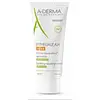What's inside
What's inside
 Key Ingredients
Key Ingredients

 Benefits
Benefits

 Concerns
Concerns

 Ingredients Side-by-side
Ingredients Side-by-side

Water
Skin ConditioningCaprylic/Capric Triglyceride
MaskingGlycerin
HumectantButyrospermum Parkii Butter
Skin ConditioningDimethicone
EmollientCetearyl Alcohol
EmollientGlyceryl Stearate
EmollientPalmitic Acid
EmollientStearic Acid
CleansingSodium Hyaluronate
HumectantAvena Sativa Leaf/Stem Extract
Skin ConditioningAlanyl Glutamine
HumectantUncaria Tomentosa Extract
Skin ConditioningBatyl Alcohol
EmollientBenzoic Acid
MaskingCaprylyl Glycol
EmollientCetearyl Glucoside
EmulsifyingDimethiconol
EmollientPolyacrylate-13
Polyisobutene
Polysorbate 20
EmulsifyingPropylene Glycol
HumectantSodium Hydroxide
BufferingSorbitan Isostearate
EmulsifyingTocopheryl Acetate
AntioxidantXanthan Gum
EmulsifyingWater, Caprylic/Capric Triglyceride, Glycerin, Butyrospermum Parkii Butter, Dimethicone, Cetearyl Alcohol, Glyceryl Stearate, Palmitic Acid, Stearic Acid, Sodium Hyaluronate, Avena Sativa Leaf/Stem Extract, Alanyl Glutamine, Uncaria Tomentosa Extract, Batyl Alcohol, Benzoic Acid, Caprylyl Glycol, Cetearyl Glucoside, Dimethiconol, Polyacrylate-13, Polyisobutene, Polysorbate 20, Propylene Glycol, Sodium Hydroxide, Sorbitan Isostearate, Tocopheryl Acetate, Xanthan Gum
Water
Skin ConditioningGlycerin
HumectantEthylhexyl Palmitate
EmollientFructooligosaccharides
HumectantZinc Oxide
Cosmetic ColorantOctyldodecanol
EmollientButylene Glycol
HumectantPolyacrylamide
Mannitol
HumectantXylitol
HumectantRhamnose
HumectantLaminaria Ochroleuca Extract
Skin ConditioningCopper Sulfate
Skin ConditioningZinc Sulfate
AntimicrobialSodium Hyaluronate
HumectantVitis Vinifera Vine Extract
Skin ConditioningAsiaticoside
AntioxidantAsiatic Acid
Skin ConditioningMadecassic Acid
Skin ConditioningC13-14 Isoparaffin
EmollientOctyldodecyl Xyloside
EmulsifyingPEG-30 Dipolyhydroxystearate
EmulsifyingCaprylic/Capric Triglyceride
MaskingLaureth-7
EmulsifyingLaureth-3
EmulsifyingHydroxyethylcellulose
Emulsion StabilisingAcetyl Dipeptide-1 Cetyl Ester
Skin ConditioningPotassium Sorbate
PreservativeWater, Glycerin, Ethylhexyl Palmitate, Fructooligosaccharides, Zinc Oxide, Octyldodecanol, Butylene Glycol, Polyacrylamide, Mannitol, Xylitol, Rhamnose, Laminaria Ochroleuca Extract, Copper Sulfate, Zinc Sulfate, Sodium Hyaluronate, Vitis Vinifera Vine Extract, Asiaticoside, Asiatic Acid, Madecassic Acid, C13-14 Isoparaffin, Octyldodecyl Xyloside, PEG-30 Dipolyhydroxystearate, Caprylic/Capric Triglyceride, Laureth-7, Laureth-3, Hydroxyethylcellulose, Acetyl Dipeptide-1 Cetyl Ester, Potassium Sorbate
 Reviews
Reviews

Ingredients Explained
These ingredients are found in both products.
Ingredients higher up in an ingredient list are typically present in a larger amount.
This ingredient is an emollient, solvent, and texture enhancer. It is considered a skin-softener by helping the skin prevent moisture loss.
It helps thicken a product's formula and makes it easier to spread by dissolving clumping compounds.
Caprylic Triglyceride is made by combining glycerin with coconut oil, forming a clear liquid.
While there is an assumption Caprylic Triglyceride can clog pores due to it being derived from coconut oil, there is no research supporting this.
Learn more about Caprylic/Capric TriglycerideGlycerin is already naturally found in your skin. It helps moisturize and protect your skin.
A study from 2016 found glycerin to be more effective as a humectant than AHAs and hyaluronic acid.
As a humectant, it helps the skin stay hydrated by pulling moisture to your skin. The low molecular weight of glycerin allows it to pull moisture into the deeper layers of your skin.
Hydrated skin improves your skin barrier; Your skin barrier helps protect against irritants and bacteria.
Glycerin has also been found to have antimicrobial and antiviral properties. Due to these properties, glycerin is often used in wound and burn treatments.
In cosmetics, glycerin is usually derived from plants such as soybean or palm. However, it can also be sourced from animals, such as tallow or animal fat.
This ingredient is organic, colorless, odorless, and non-toxic.
Glycerin is the name for this ingredient in American English. British English uses Glycerol/Glycerine.
Learn more about GlycerinSodium Hyaluronate is hyaluronic acid's salt form. It is commonly derived from the sodium salt of hyaluronic acid.
Like hyaluronic acid, it is great at holding water and acts as a humectant. This makes it a great skin hydrating ingredient.
Sodium Hyaluronate is naturally occurring in our bodies and is mostly found in eye fluid and joints.
These are some other common types of Hyaluronic Acid:
Learn more about Sodium HyaluronateWater. It's the most common cosmetic ingredient of all. You'll usually see it at the top of ingredient lists, meaning that it makes up the largest part of the product.
So why is it so popular? Water most often acts as a solvent - this means that it helps dissolve other ingredients into the formulation.
You'll also recognize water as that liquid we all need to stay alive. If you see this, drink a glass of water. Stay hydrated!
Learn more about Water